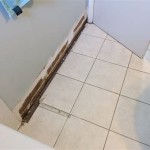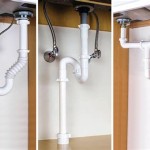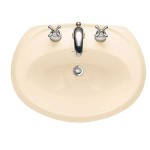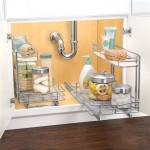How To Fix a Chipped Bathroom Sink
A chipped bathroom sink, while seemingly a minor cosmetic issue, can detract from the overall aesthetic of a bathroom and potentially lead to further damage if left unaddressed. The exposed material beneath the surface can become a breeding ground for bacteria and mold, and the chip itself can expand over time due to water damage and temperature fluctuations. Fortunately, repairing a chipped bathroom sink is often a manageable DIY project, saving the expense of professional repairs or sink replacement. This article will provide a detailed guide on how to effectively fix a chipped bathroom sink, covering the necessary materials, step-by-step instructions, and important considerations for achieving a lasting and visually appealing result.
Before embarking on the repair, it is crucial to properly assess the damage. Is it a small, shallow chip or a larger, more significant piece missing? The size and depth of the chip will influence the choice of repair materials and the complexity of the repair process. Examine the surrounding area for any signs of cracking or weakening, as this may indicate a larger underlying problem. Identifying the material of the sink (e.g., porcelain, enamel, acrylic, or cast iron) is also essential, as different materials require specific repair compounds and techniques.
Once the assessment is complete, gathering the appropriate tools and materials is the next step. A well-stocked toolkit will streamline the repair process and ensure a professional-looking finish. The following items are typically required:
- Repair Kit: Select a repair kit specifically designed for the type of sink material. These kits usually include a filler compound, hardener, application tools, and color-matching pigments.
- Cleaning Supplies: Mild dish soap, water, a soft sponge, and a clean, dry cloth are necessary for cleaning the sink surface before and after the repair.
- Rubbing Alcohol: Used to degrease the chipped area and ensure proper adhesion of the repair compound.
- Sandpaper: Various grits of sandpaper (e.g., 220, 400, 600) are needed for smoothing the repaired area and blending it with the surrounding surface.
- Putty Knife or Small Spatula: Used to apply and smooth the filler compound.
- Mixing Container and Stirring Stick: For mixing the filler compound and hardener according to the manufacturer's instructions.
- Painter's Tape: To protect the surrounding area from accidental scratches or smudges.
- Safety Glasses and Gloves: To protect eyes and skin from potentially harmful chemicals.
With the preparation completed, the actual repair process can begin. The following steps outline a general procedure for fixing a chipped bathroom sink. However, it is crucial to always refer to the specific instructions provided with the chosen repair kit, as variations may exist depending on the product.
Key Point 1: Thorough Cleaning and Preparation
The success of the repair hinges on proper surface preparation. Start by thoroughly cleaning the sink with mild dish soap and water to remove any dirt, grease, or residue. Rinse the sink thoroughly and dry it with a clean cloth. Next, use rubbing alcohol to degrease the chipped area and the surrounding surface. This step is critical for ensuring proper adhesion of the repair compound. Allow the alcohol to evaporate completely before proceeding. Apply painter's tape around the chipped area to protect the surrounding surface from accidental scratches or smudges. This will also help to create a clean and defined edge for the repair.
If the chipped area has any sharp edges or loose fragments, carefully remove them using a small knife or scraper. Gently sand the edges of the chip with a fine-grit sandpaper (e.g., 220-grit) to create a slightly roughened surface. This will provide a better bonding surface for the repair compound. Be careful not to apply too much pressure, as this could further damage the surrounding area. Wipe away any sanding dust with a clean, damp cloth.
Ensure that the area is completely dry before proceeding to the next step. Moisture can interfere with the curing process of the repair compound and compromise the durability of the repair. Using a hairdryer on a low setting can help to expedite the drying process.
Key Point 2: Applying and Smoothing the Repair Compound
Following the manufacturer's instructions, carefully mix the filler compound and hardener in the provided mixing container. Ensure that the mixture is thoroughly combined and free of any lumps or streaks. The consistency of the mixture should be similar to that of toothpaste. Use the provided stirring stick to achieve a uniform consistency. It is important to work quickly, as the repair compound may begin to harden relatively quickly.
Using a putty knife or small spatula, carefully apply the mixed repair compound to the chipped area. Overfill the chip slightly, ensuring that the compound completely covers the damaged area and extends slightly beyond the edges. This will allow for sanding and shaping the repair to match the surrounding surface. Avoid applying excessive pressure, as this could push the compound out of the chip. Instead, use gentle strokes to fill the void.
Once the chip is filled, use the putty knife or spatula to smooth the surface of the repair compound. Aim to create a smooth, even surface that is flush with the surrounding sink surface. Remove any excess compound with the putty knife or spatula. Wipe the tool clean after each pass to prevent the spread of excess compound. If necessary, use a slightly damp cloth or sponge to further smooth the surface. Be careful not to remove too much compound, as this could leave the repair area sunken below the surrounding surface.
Allow the repair compound to cure completely according to the manufacturer's instructions. This typically takes several hours or even overnight. Avoid touching or disturbing the repair area during the curing process. Keep the area dry and protected from any moisture or direct sunlight. Check the manufacturer's instructions for specific curing times and recommendations.
Key Point 3: Sanding and Finishing Touches
Once the repair compound has fully cured, it is time to sand and finish the repaired area. Start with a medium-grit sandpaper (e.g., 400-grit) to remove any excess compound and blend the repair with the surrounding surface. Sand in gentle, circular motions, being careful not to scratch the surrounding area. Avoid applying too much pressure, as this could damage the repaired area. Periodically wipe away the sanding dust with a clean, damp cloth to assess the progress.
After the initial sanding, switch to a finer-grit sandpaper (e.g., 600-grit) to further smooth the surface and remove any remaining imperfections. Continue to sand in gentle, circular motions, gradually blending the repair with the surrounding surface. The goal is to create a seamless transition between the repaired area and the original sink surface. Again, periodically wipe away the sanding dust to assess the progress.
If the repair kit includes color-matching pigments, carefully mix the pigments according to the manufacturer's instructions to match the color of the sink. Apply the mixed pigment to the repaired area using a small brush or sponge. Apply thin, even coats, allowing each coat to dry completely before applying the next. This will help to create a uniform and consistent color. Once the color is matched, apply a sealant or polish to protect the repaired area and enhance its shine. Follow the manufacturer's instructions for application and curing times.
Finally, remove the painter's tape and clean the surrounding area with a mild detergent. Inspect the repaired area for any remaining imperfections or inconsistencies. If necessary, repeat the sanding and finishing steps to achieve a flawless result. With proper care and maintenance, the repaired chipped bathroom sink should provide years of reliable service.
Beyond the practical aspects of the repair, it is essential to consider the long-term maintenance of the bathroom sink. Avoiding harsh chemicals and abrasive cleaners will help to protect the repaired area and prevent future damage. Regularly cleaning the sink with mild soap and water will help to maintain its appearance and prevent the buildup of grime and stains. Promptly addressing any new chips or cracks will prevent them from expanding and causing more significant problems. Furthermore, understanding the potential causes of chips, such as dropping heavy objects or exposing the sink to extreme temperature changes, can help to prevent future occurrences. By taking these preventative measures, the lifespan of the bathroom sink can be significantly extended.
In conclusion, repairing a chipped bathroom sink is a feasible DIY project that can save money and improve the aesthetic appeal of the bathroom. By carefully assessing the damage, gathering the appropriate materials, and following the step-by-step instructions outlined above, homeowners can effectively restore their chipped bathroom sink to its original condition. Proper preparation, meticulous application, and careful finishing are key to achieving a durable and visually appealing repair. Regular maintenance and preventative measures will help to ensure the longevity of the repair and the overall lifespan of the bathroom sink.

How To Patch A Porcelain Sink Himg Surface Repair

How To Fix A Ed Porcelain Sink Hometalk

How To Fix A Ed Porcelain Sink 8 Steps Prudent Reviews

Gorgeous Shiny Things How To Repair A Porcelain Sink

How To Repair A Hairline In Porcelain Sink 6 Steps

How To Fix A Ed Porcelain Sink 8 Steps Prudent Reviews

Sink Repair Happy Tubs Bathtub

Magic 0 17 Oz Porcelain Chip Fix Repair For Tubs And Sinks 3007a The Home Depot

Porcelain Sink Chip Fix

Quick Fix For Chip In Porcelain Sink Airbnb Hosts Forum
Related Posts







